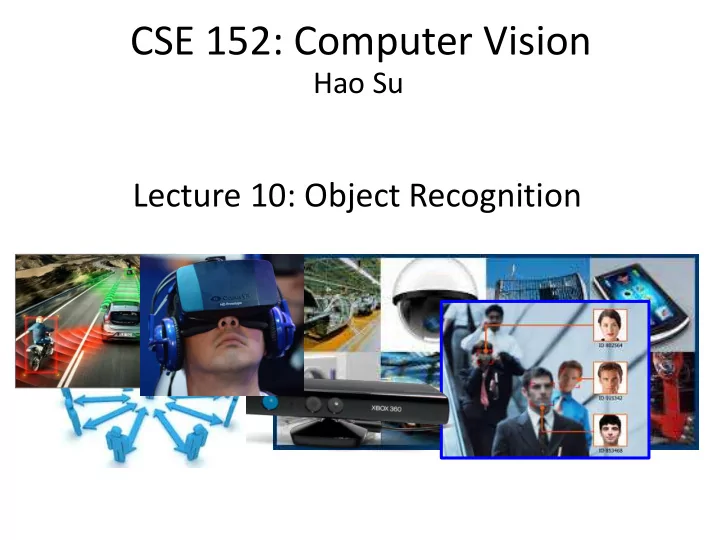

CSE 152: Computer Vision Hao Su Lecture 10: Object Recognition
How do we represent objects - Bounding box Figures from https://github.com/facebookresearch/detectron2
How do we represent objects - Bounding box - Instance mask Figures from https://github.com/facebookresearch/ detectron2
How do we represent objects - Bounding box - Instance mask - Keypoint Figures from https://github.com/facebookresearch/ detectron2
How do we represent objects - Bounding box - Instance mask - Keypoint Figures from https://github.com/facebookresearch/ detectron2
Object Detection with Bounding Boxes What? - Recognition/ Classification Where? - Localization/ Regression Slides modified from Ross Girshick tutorial at CVPR 2019
Object Detection with Segmentation Masks What? - Recognition Where? - Segmentation Slides modified from Ross Girshick tutorial at CVPR 2019
Semantic Segmentation Predict a pixel-wise class label Stuff: walls, buildings, sky, road Things: human, cars, bikes Figures from Panoptic Segmentation , CVPR 2019
Datasets Microsoft COCO
Object Detection
Object Detection → Object Classification Enumerate / Crop and resize heuristic algorithm (warp) Input: an image Proposals/Candidates Cropped image We’ve already reduced object detection to object classification! Slides modified from Ross Girshick tutorial at CVPR 2019
R-CNN (Regional ConvNet) Computationally expensive Cropped image Region of Interests (RoI) Enumerate / heuristic algorithm ConvNet Input: an image Proposals/Candidates Class Probability How probable is it a human? BBox Regression How can we modify this bounding box? Slides modified from Ross Girshick tutorial at CVPR 2019
Faster R-CNN Proposals/Candidates Region of Interests (RoI) Input: an image Class Probability BBox Regression Region Proposal Network (RPN) ConvNet Multilayer Perceptron (MLP) ConvNet RoI-Pool Similar to Crop & Resize Feature map for an image Feature map for a RoI Slides modified from Ross Girshick tutorial at CVPR 2019
Faster R-CNN • At each location, consider boxes of many different sizes and aspect ratios
Faster R-CNN • At each location, consider boxes of many different sizes and aspect ratios
Object Segmentation
Semantic Segmentation Idea: Fully Convolutional Design a network as a bunch of convolutional layers to make predictions for pixels all at once! Conv Conv Conv Conv argmax Input: Predictio Score 3 x H x ns: H s: C x Convolutio W x W H x W ns: D x H x W Lecture May 10, 11 - 2017
Semantic Segmentation Idea: Fully Convolutional Design network as a bunch of convolutional layers, with downsampling and upsampling inside the network! Med-res: Med-res: D 2 x H/4 x W/4 D 2 x H/4 x W/4 Low- res: D 3 x Input: High- High- H/4 x W/4 Predictio 3 x H x res: D 1 x res: D 1 x ns: H W H/2 x W/2 H/2 x W/2 x W Lecture May 10, 11 - 2017 Long, Shelhamer, and Darrell, “Fully Convolutional Networks for Semantic Segmentation”, CVPR 2015 Noh et al, “Learning Deconvolution Network for Semantic Segmentation”, ICCV 2015
Semantic Segmentation Idea: Fully Convolutional Design network as a bunch of convolutional layers, with downsampling and upsampling inside the network! Downsampling : Upsampling : ??? Pooling, strided Med-res: Med-res: convolution D 2 x H/4 x W/4 D 2 x H/4 x W/4 Low- res: D 3 x Input: High- High- H/4 x W/4 Predictio 3 x H x res: D 1 x res: D 1 x ns: H W H/2 x W/2 H/2 x W/2 x W Lecture May 10, 11 - 2017 Long, Shelhamer, and Darrell, “Fully Convolutional Networks for Semantic Segmentation”, CVPR 2015 Noh et al, “Learning Deconvolution Network for Semantic Segmentation”, ICCV 2015
Learnable Upsampling: Transpose Convolution Sum where 3 x 3 transpose convolution, output overlaps stride 2 pad 1 Filter moves 2 pixels in the output for every one Input pixel in the input gives weight Stride gives ratio for filter between movement in output and input Input: 2 x 2 Output: 4 x 4
Learnable Upsampling: Transpose Convolution Sum where 3 x 3 transpose convolution, output overlaps stride 2 pad 1 Filter moves 2 pixels in the output for every one Input pixel in the input gives weight Stride gives ratio for filter between movement in output and input Input: 2 x 2 Output: 4 x 4 Other names: -Deconvolution (bad) -Upconvolution -Fractionally strided convolution -Backward strided convolution
Semantic vs. Instance Segmentation Slides modified from Ross Girshick tutorial at CVPR 2019
Mask R-CNN • First do object detection using the Faster R-CNN arch, and then do semantic segmentation inside the cropped region • Share features of the first few layers for detection and segmentation
Recommend
More recommend